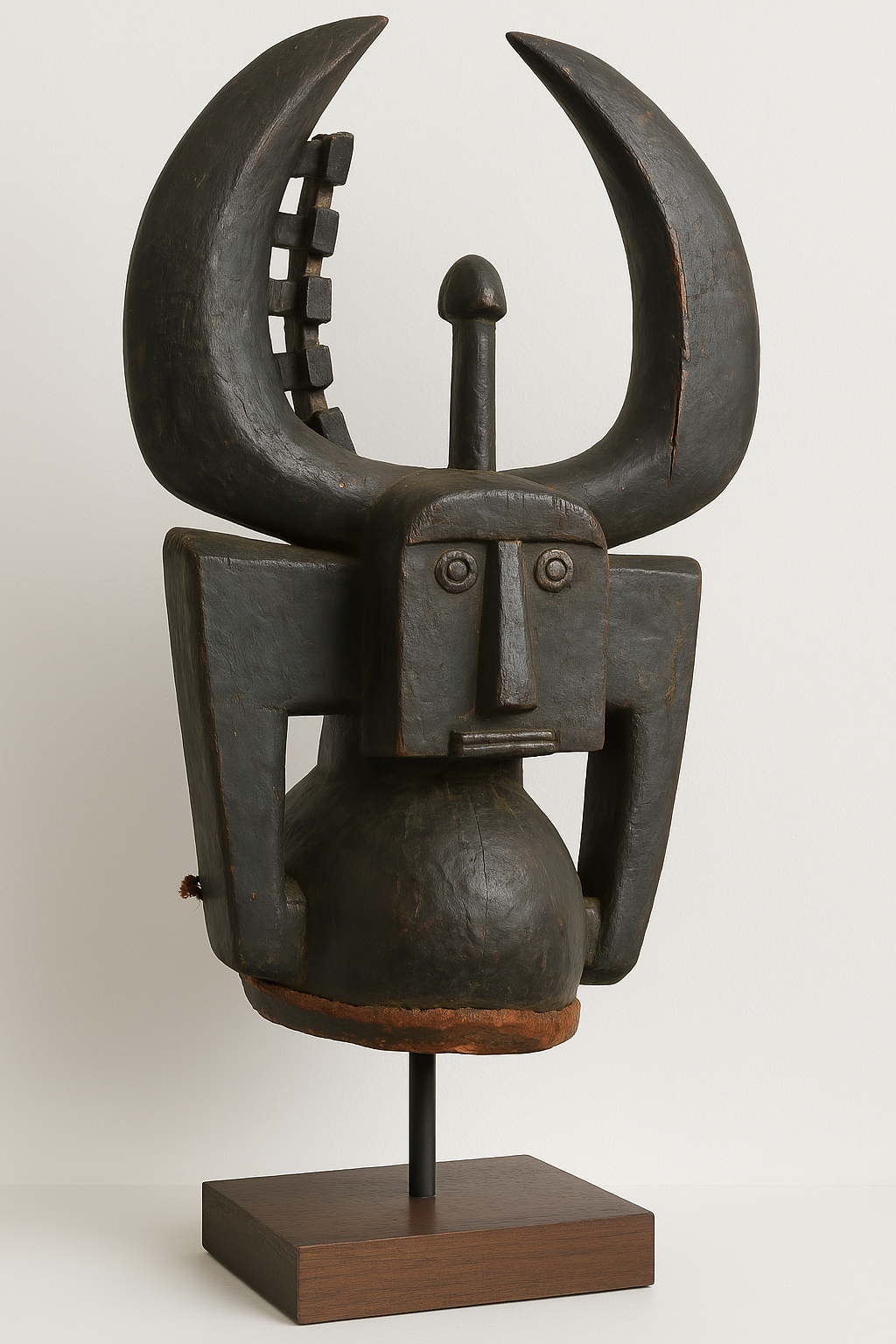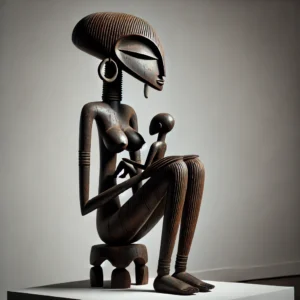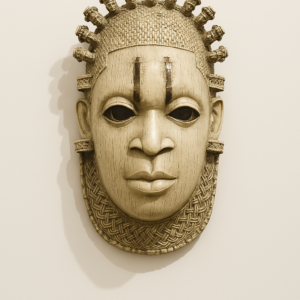Wajumbe wa Roho (Swahili for “Messengers of the Spirit”)
Wajumbe wa Roho is an arresting example of African tribal symbolism and spiritual craftsmanship. Translating from Swahili as “Messengers of the Spirit,” this sculpture encapsulates the essence of traditional African mask-making and ancestral reverence. The piece draws immediate attention with its imposing crescent-shaped horns, squared shoulders, and otherworldly gaze, all carefully carved from a single piece of aged wood and mounted on a minimalist pedestal. It is a celebration of mystery, ritual, and ancestral memory—evoking both the tangible and intangible realms of African culture.
This striking sculpture appears to be heavily inspired by the Kpelie or Baga Nimba mask traditions, found in regions such as Mali, Guinea, and Côte d’Ivoire. These masks were often used in ceremonies related to harvest, fertility, or ancestral worship. They were not merely decorative items but held immense spiritual weight—believed to channel energies, tell stories, or protect villages through dance and ritual. Wajumbe wa Roho honors this tradition by capturing the essence of symbolic abstraction, spiritual geometry, and mythic representation.
The head of the sculpture is dominated by two arched horns that sweep upward like a crescent moon, a form associated with lunar cycles, transformation, and spiritual balance. A central vertical staff, rising like a spine between the horns, echoes ancient staff designs carried by tribal leaders or spiritual mediators. Beneath it, a stylized, mask-like face features hollow eyes, a pronounced nose, and a rectangular mouth—resembling ancestral spirits who watch silently but powerfully over the living.
Crafted from solid carved wood, this piece measures approximately 28 inches in height, 12 inches in width, and 10 inches in depth, resting atop a wooden and metal stand. It weighs around 15 pounds, giving it presence without sacrificing portability. The wood is dark and aged, revealing signs of ceremonial wear and surface patina. Cracks, scratches, and burnished edges contribute to its visual authenticity, as if it has traveled through time, ceremonies, and memory to arrive in the present.
The body of the sculpture is geometric and symmetrical, featuring two robust, angular arms that resemble pillars of strength, possibly symbolizing groundedness or earthly power. Below them is a rounded belly form, often found in African fertility figures, suggesting nurturing, life-giving energy, or balance between strength and softness. The entire form is mounted on a museum-style base—a blend of dark-stained hardwood and a blackened steel rod—to elevate the piece and showcase it with gallery-quality elegance.
Wajumbe wa Roho is more than an art object. It is a visual echo of a voice passed down generations—silent, but charged with memory and meaning. It serves as a bridge between the visible and invisible worlds, between heritage and modern space. When placed in a contemporary setting, it brings a raw and reverent contrast. In minimalist interiors, it becomes a centerpiece; in bohemian or tribal-themed spaces, it becomes a spiritual companion.
This sculpture is ideal for cultural collectors, art historians, gallery curators, and lovers of African symbolism. Whether featured in a modern loft, museum corridor, meditation room, or home gallery, it holds an undeniable gravity. Its gaze feels ancient yet immediate. Its form feels otherworldly yet human. It’s the kind of piece that doesn’t just sit in a room—it defines it.
Every version of Wajumbe wa Roho is handcrafted, meaning no two are ever exactly alike. Variations in grain, tone, and wear are all part of the sculptural language. The piece comes securely packaged in a double-reinforced, foam-fitted shipping crate and requires no assembly. Simply unpack, place, and invite the energy in.
In a time when handcrafted work is increasingly rare, Wajumbe wa Roho stands as a testament to cultural storytelling through form—an art that speaks not just to the eyes, but to the spirit.





Reviews
There are no reviews yet.